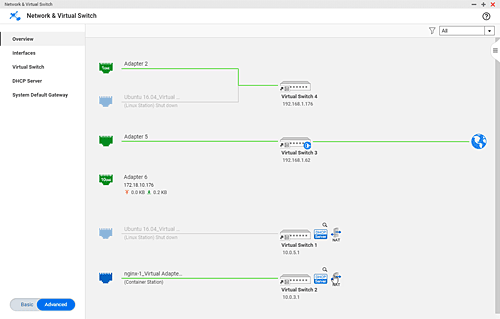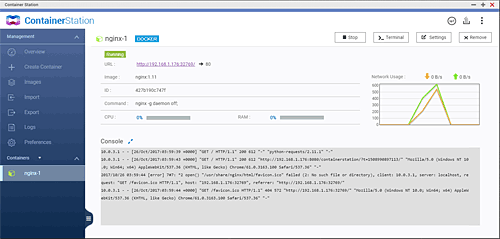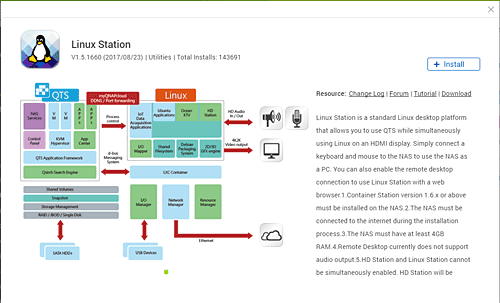It’s pretty common these days to see server systems used as dual-purpose platforms for both compute and storage. That trend has also made its way over to the world of storage systems, as more vendors are adding server-like capabilities to their storage products.
QNAP is one of those storage vendors that has been adding services like containers and virtualization plus the ability to run any number of different services right on the storage box.
The company’s new QNAP TS-1685 could replace a small departmental server in small to medium-sized business environments with everything you get inside the box. This unit ships with QTS 4.3, the latest version of QNAP’s network-attached storage (NAS) operating system.
The QNAP TS-1685 also has the horsepower needed to adequately run those applications and services. We put the unit through its paces, including connecting over iSCSI to servers running VMware vSphere and Microsoft’s Hyper-V.
QNAP TS-1685 Hardware
Take one look at the QNAP TS-1685 and you can tell this unit has a ton of capacity. Twelve full-size 3.5-inch drive bays plus four 2.5-inch slots will handle the latest high-capacity hard drives or solid state disks for speed. Add to that a total of six M.2 slots and you have a whopping support for twenty-two disk devices in a desktop space.
Our review unit came with an Intel Xeon D-1531 CPU running at 2.20 GHz and 32 GB of memory (see Figure 1). The Xeon D-1531 has six cores and scores a respectable 9730 on the Passmark CPU benchmark test.
On the networking side, the QNAP TS-1685 shines with four 1 GB ports plus two 10 GB ports. Management of the network settings happens using the Network & Virtual Switch applet. Figure 2 shows the Overview page with the physical adapters and associated Virtual Switches.
Since this box provides a range of services that require network access, it makes sense to have a virtual networking management feature. This is depicted in Figure 2 with the nginx-1 container connected to Virtual Switch 2 using the 10.0.3.1 network.
Our test unit came with three Seagate IronWolf 2TB drives that operate at 7200 RPM. Western Digital also provided us with four of their Red 10TB NAS hard disk drives to use for backup and archival storage.
We also used two Intel DC S3500 120GB SSDs to function as a caching tier. Individual SSDs or a RAID group of multiple drives can be attached to an existing volume to speed up access.
The Storage Manager application provides a complete graphical interface for all storage-related tasks. The overview page shows the status of all physical devices and volumes.
Software Included in the QNAP TS-1685
QNAP has been continually improving their QTS operating system for a long time. The latest 4.3 version provides a wide range of capabilities you wouldn’t normally expect to find on a storage box. With the ability to run containers the QNAP TS-1685 can now take full advantage of even more applications available through the Docker ecosystem.
Installing applications happens from the app center interface. This is where you install capabilities like Container Station. Container Station offers full support for both LXC and Docker containers.
To test this feature we installed the app and then used the Create Container option to install the latest version of Nginx. Figure 3 shows the status page for a running instance of Nginx that includes a URL for web access. We also installed the Linux Station app (see Figure 4), which uses Container Station to launch a Linux desktop platform accessible over the web.
For VMware users, QTS supports vStorage APIs for Array Integration (VAAI), which brings a number of improvements like the ability to minimize network traffic for operations like cloning and copying. VAAI support includes both NAS (NFS) and iSCSI-based volumes. On the iSCSI side you get full support for things like hardware-assisted copying and zeroing.
QTS provides the same type of support for Microsoft Hyper-V hosts using Offloaded Data Transfer (ODX). For virtualization management, QNAP offers a snap-in for both VMware vCenter and Microsoft’s System Center Virtual Machine Manager (SCVMM).
QTS 4.3 provides an easy-to-use web-based graphical interface for all management functions. The Control Panel app is where the basic configuration of the NAS functionality happens such as updating firmware, creating and coordinating users, managing the variety of storage services offered to include iSCSI, NFS, SMB and more.
You can even enable a built-in SQL server running MariaDB 5.5.57 right from the Control Panel app. Management of the database does require a second installation of phpMyAdmin offered on the SQL server page.
Bottom Line
If you haven’t picked up on the versatility of this device you haven’t been paying attention. The QNAP TS-1685 is really a powerhouse of a box that does so much more than simply serve files.
It presents a practical replacement opportunity for many small business servers and even up into the SMB space. If you’re looking to upgrade an older office server, you should take a hard look at the QNAP TS-1685 as it’s definitely worth considering.
Paul Ferrill, based in Chelsea, Alabama, has been writing about computers and software for almost 20 years. He has programmed in more languages than he cares to count, but now leans toward Visual Basic and C#.





